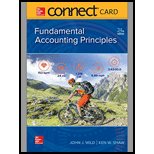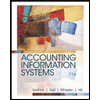
Connect Access Card For Fundamental Accounting Principles
24th Edition
ISBN: 9781260158526
Author: John J Wild
Publisher: McGraw-Hill Education
expand_more
expand_more
format_list_bulleted
Textbook Question
Chapter 5, Problem 12E
Exercise 5-12 Impacts of inventory error on key accounts P3
A retailer completed a physical count of ending merchandise inventory. When counting inventory, employees did not include S3.000 of incoming goods shipped by a supplier on December 31 under FOB shipping point. These goods had been recorded in Merchandise Inventory, but they -were not included in the physical count because they were in transit. This means shrinkage was incorrectly overstated by $3,000.
Compute the amount of overstatement or understatement for each of the following amounts for this period.
a. Ending inventory
b. Total assets C. Net income d. Total equity
Expert Solution & Answer
Want to see the full answer?
Check out a sample textbook solution
Students have asked these similar questions
Which item would appear on the statement of retained earnings?A. DividendsB. InventoryC. Prepaid RentD. Notes Payable
What does a classified balance sheet do that an unclassified one does not?A. Uses the cash basis of accountingB. Categorizes assets and liabilities into current and long-termC. Shows only owner’s equityD. Omits depreciation
4. The normal balance of an asset account is:A. CreditB. DebitC. ZeroD. It depends on the assetno ai
Chapter 5 Solutions
Connect Access Card For Fundamental Accounting Principles
Ch. 5 - Prob. 1DQCh. 5 - Prob. 2DQCh. 5 - Prob. 3DQCh. 5 - Prob. 4DQCh. 5 - 5. How does a company that uses a perpetual...Ch. 5 - Prob. 6DQCh. 5 - What is the difference between a sales discount...Ch. 5 - Prob. 8DQCh. 5 - Prob. 9DQCh. 5 - What is the difference between the single-step and...
Ch. 5 - Prob. 11DQCh. 5 - Prob. 12DQCh. 5 - Prob. 13DQCh. 5 - Refer to the income statement of Samsung in...Ch. 5 - Prob. 15DQCh. 5 - Applying merchandising terms C1 P1 Enter the...Ch. 5 - Identifying inventory costs C2 Costs of $5.000...Ch. 5 - Merchandise accounts and computations C2 Use the...Ch. 5 - Computing net invoice amounts P1 Compute the...Ch. 5 - Recording purchases, returns, and discounts taken...Ch. 5 - Recording purchases and discounts taken P1 Prepare...Ch. 5 - Recording purchases and discounts missed Pl...Ch. 5 - Recording sales, returns, and discounts taken P2...Ch. 5 - Accounting for shrinkage—perpetual system P3...Ch. 5 - Closing entries P3 Refer to QS 5-9 and prepare...Ch. 5 - Multiple-step income statement P4 For each item...Ch. 5 - Preparing a multiple-step income statement P4...Ch. 5 - Exercise 5-13 Physical count error and profits A2...Ch. 5 - Prob. 14QSCh. 5 - Prob. 15QSCh. 5 - Prob. 16QSCh. 5 - Recording purchases, returns, and...Ch. 5 - Recording sales. returns, and discounts—periodic &...Ch. 5 - Prob. 19QSCh. 5 - Prob. 20QSCh. 5 - Prob. 21QSCh. 5 - Prob. 22QSCh. 5 - QS 5-23 Sales transactions P2
Prepare journal...Ch. 5 - Exercise 5-1 Computing revenues, expenses, and...Ch. 5 - Prob. 2ECh. 5 - Exercise 5-3 Recording purchases, purchases...Ch. 5 - Exercise 5-4 Recording sales, sales returns, and...Ch. 5 - Exercise 5.5 Recording purchases, purchases...Ch. 5 - Exercise 5-6 Recording sales, purchases, and cash...Ch. 5 - Exercise 5-7 Recording sales, purchases, shipping,...Ch. 5 - Exercise 5-8 Inventory and cost of sales...Ch. 5 - Exercise 5-9 Recording purchases, sales, returns,...Ch. 5 - Exercise 5-10 Preparing adjusting and closing...Ch. 5 - Prob. 11ECh. 5 - Exercise 5-12 Impacts of inventory error on key...Ch. 5 - Exercise 5-13 Physical count error and profits...Ch. 5 - Prob. 14ECh. 5 - Prob. 15ECh. 5 - Prob. 16ECh. 5 - Prob. 18ECh. 5 - Prob. 19ECh. 5 - Prob. 20ECh. 5 - Prob. 21ECh. 5 - Prob. 22ECh. 5 - Prob. 23ECh. 5 - Prob. 24ECh. 5 - Prob. 25ECh. 5 - Problem 5-1A
Preparing journal entries for...Ch. 5 - Problem 5-2A
Preparing journal entries for...Ch. 5 - Problem 5-3A Computing merchandising amounts and...Ch. 5 - Problem 5-4A Preparing closing entries and...Ch. 5 - Prob. 5APSACh. 5 - Problem 5-1 B
Preparing journal entries for...Ch. 5 - Problem 5-2B
Preparing journal entries for...Ch. 5 - Problem 5-3B Computing merchandising amounts and...Ch. 5 - Problem 5-4B Preparing closing entries and...Ch. 5 - Problem 5-5B Preparing adjusting entries and...Ch. 5 - SP 5 Santana Rey created Business Solutions on...Ch. 5 - Prob. 1GLPCh. 5 - Prob. 2GLPCh. 5 - Prob. 3GLPCh. 5 - Prob. 1AACh. 5 - Key comparative figures for Apple and Google...Ch. 5 - Prob. 3AACh. 5 - Prob. 1BTNCh. 5 - Prob. 2BTNCh. 5 - Prob. 3BTNCh. 5 - Prob. 4BTNCh. 5 - Prob. 5BTNCh. 5 - Prob. 6BTN
Knowledge Booster
Learn more about
Need a deep-dive on the concept behind this application? Look no further. Learn more about this topic, accounting and related others by exploring similar questions and additional content below.Similar questions
- 4. The normal balance of an asset account is:A. CreditB. DebitC. ZeroD. It depends on the assetneed helparrow_forward4. The normal balance of an asset account is:A. CreditB. DebitC. ZeroD. It depends on the assetarrow_forwardA contingent liability should be recorded only when:A. It is possible and the amount is estimableB. It is probable and the amount is estimableC. It is certain to occurD. Management decides it’s importantDont use AIarrow_forward
- A contingent liability should be recorded only when:A. It is possible and the amount is estimableB. It is probable and the amount is estimableC. It is certain to occurD. Management decides it’s important need helparrow_forwardA contingent liability should be recorded only when:A. It is possible and the amount is estimableB. It is probable and the amount is estimableC. It is certain to occurD. Management decides it’s importantarrow_forwardNo chatgpt 6. Which of the following is not an intangible asset?A. GoodwillB. PatentC. TrademarkD. Landarrow_forward
- Need help hi 6. Which of the following is not an intangible asset?A. GoodwillB. PatentC. TrademarkD. Landarrow_forward6. Which of the following is not an intangible asset?A. GoodwillB. PatentC. TrademarkD. Land i need helparrow_forward6. Which of the following is not an intangible asset?A. GoodwillB. PatentC. TrademarkD. Landneed helparrow_forward
- 6. Which of the following is not an intangible asset?A. GoodwillB. PatentC. TrademarkD. Landarrow_forwardWhich basis of accounting recognizes revenues and expenses when cash is exchanged?A. AccrualB. Modified AccrualC. Cash BasisD. Matchingneedarrow_forwardWhich basis of accounting recognizes revenues and expenses when cash is exchanged?A. AccrualB. Modified AccrualC. Cash BasisD. Matchingneed helparrow_forward
arrow_back_ios
SEE MORE QUESTIONS
arrow_forward_ios
Recommended textbooks for you
 AccountingAccountingISBN:9781337272094Author:WARREN, Carl S., Reeve, James M., Duchac, Jonathan E.Publisher:Cengage Learning,
AccountingAccountingISBN:9781337272094Author:WARREN, Carl S., Reeve, James M., Duchac, Jonathan E.Publisher:Cengage Learning, Cornerstones of Financial AccountingAccountingISBN:9781337690881Author:Jay Rich, Jeff JonesPublisher:Cengage Learning
Cornerstones of Financial AccountingAccountingISBN:9781337690881Author:Jay Rich, Jeff JonesPublisher:Cengage Learning Accounting Information SystemsFinanceISBN:9781337552127Author:Ulric J. Gelinas, Richard B. Dull, Patrick Wheeler, Mary Callahan HillPublisher:Cengage Learning
Accounting Information SystemsFinanceISBN:9781337552127Author:Ulric J. Gelinas, Richard B. Dull, Patrick Wheeler, Mary Callahan HillPublisher:Cengage Learning Financial Accounting: The Impact on Decision Make...AccountingISBN:9781305654174Author:Gary A. Porter, Curtis L. NortonPublisher:Cengage Learning
Financial Accounting: The Impact on Decision Make...AccountingISBN:9781305654174Author:Gary A. Porter, Curtis L. NortonPublisher:Cengage Learning Corporate Financial AccountingAccountingISBN:9781305653535Author:Carl Warren, James M. Reeve, Jonathan DuchacPublisher:Cengage Learning
Corporate Financial AccountingAccountingISBN:9781305653535Author:Carl Warren, James M. Reeve, Jonathan DuchacPublisher:Cengage Learning

Accounting
Accounting
ISBN:9781337272094
Author:WARREN, Carl S., Reeve, James M., Duchac, Jonathan E.
Publisher:Cengage Learning,

Cornerstones of Financial Accounting
Accounting
ISBN:9781337690881
Author:Jay Rich, Jeff Jones
Publisher:Cengage Learning

Accounting Information Systems
Finance
ISBN:9781337552127
Author:Ulric J. Gelinas, Richard B. Dull, Patrick Wheeler, Mary Callahan Hill
Publisher:Cengage Learning

Financial Accounting: The Impact on Decision Make...
Accounting
ISBN:9781305654174
Author:Gary A. Porter, Curtis L. Norton
Publisher:Cengage Learning


Corporate Financial Accounting
Accounting
ISBN:9781305653535
Author:Carl Warren, James M. Reeve, Jonathan Duchac
Publisher:Cengage Learning
Accounting Changes and Error Analysis: Intermediate Accounting Chapter 22; Author: Finally Learn;https://www.youtube.com/watch?v=c2uQdN53MV4;License: Standard Youtube License